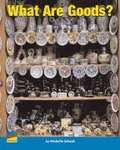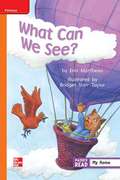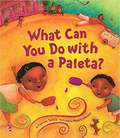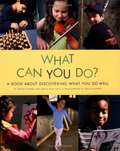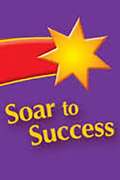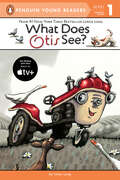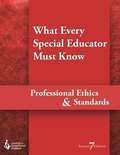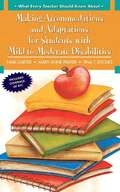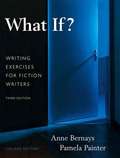- Table View
- List View
What Are Goods?
by Vicki Rushworth David Haggerty Michelle SchaubIn this book, learn what goods are, where they come from, and how they are transported to stores.
What Can We See? [Approaching Level, Grade 1]
by Bridget Starr Taylor Erin MatthewsNIMAC-sourced textbook
What Can You Do with a Paleta? (Elementary Core Reading)
by Carmen Tafolla Magaly MoralesNIMAC-sourced textbook
What Can You Do?
by Linda Lott Ginger NielsonThe fun and excitement of English and Language Arts learning continues in Grade 2 of Reading Street. This comprehensive and dynamic curriculum for homeschooling is geared toward young children who have some foundational English and Language Arts knowledge and are ready to strengthen their skills. Comprised of engaging activities, challenging content and weekly quizzes, Reading Street: Grade 2 is the next step in your child's path toward becoming a lifelong learner and reader. As with all Reading Street products, the Grade 2 system is formatted to help students meet certain age-appropriate goals. After completing this English and Language Arts homeschool program, your child should be able to: Read and comprehend two-syllable words. Identify common prefixes (such as pre-, un-, or re-) and suffixes (such as -able, -ad and -er). Correct mistakes made when reading out loud. Read books with two or more chapters. Understand the structure of stores (i. e. beginning, middle and end). Start selecting reading materials based on his/her own interests. Identify the "who," "what," "when," "where," "why" and "how" of the text. While the goals of second Grade English and Language Arts are numerous, Reading Street will help you craft engrossing lessons. Your child will garner important English and Language Arts skills while completing a workbook, reading stories and poems, and taking assessments. Planning these lessons will be easier than ever, as all Reading Street systems are broken down into weekly Big Ideas. All the work your child does on a given week is formulated around that single concept for an organized and challenging curriculum. With six easy-to-follow units, Reading Street: Grade 2 is the perfect tool for homeschooling parents. Your child will enjoy the reading selections and activities, and you'll love to see your student growing into a knowledgeable individual. We're confident that this product is the right one for you. For more information on the specific materials found in Grade 2 of Reading Street, check out the Features and Benefits page.
What Can You Do?: A Book About Discovering What You Do Well (Into Reading, Read Aloud Module 10)
by Shelley Rotner Sheila KellyNIMAC-sourced textbook <P><P>What Can You Do? is a book to help children discover their own special talents. Inspired by Dr. Howard Gardner's Frames of Mind, in which he outlines seven different kinds of intelligence, the book helps children realize that succes comes in many forms. While one child might excel in mathematics, another might shine as an actor or a painter. The top reader in the class may not be a good skier, and vice versa. The authors hope to offer children and the adults who care for them a chance to think and talk about ways children have met with success or difficulty in using their abilities, and to help them recognize that one ability is not better than another. This understanding will encourage children to seek help with their challenges and to delight in their strengths.
What Do You Do When Something Wants To Eat You?: Soar To Success Student Book Level 3 Wk 8
by Steve JenkinsA hungry wolf's attempts to fatten a chicken for his stewpot have unexpected results. NIMAC-sourced textbook
What Do You Expect: Probability and Expected Value (Texas)
by Inc. Glenda Lappan James T. Fey William M. Fitzgerald Susan N. Friel Elizabeth Difanis Phillips WestWordsNIMAC-sourced textbook
What Do You Expect? Probability and Expected Value (Connected Mathematics)
by Glenda Lappan James T. Fey Susan N. Friel Elizabeth Difanis PhillipsThe contents of the book include: A First Look at Chance, Experimental and Theoretical Probability, Making Decisions with Probability, Analyzing Compound Events Using an Area Model, Binomial Outcomes, Unit Project, English/Spanish Glossary, etc.
What Does Otis See? (Otis)
by Loren LongWatch Get Rolling with Otis on Apple TV!Featuring the New York Times bestselling character Otis! Join Otis as he explores the many fun things there are to see on the farm! In this new leveled reader, Otis sees a puppy, a little calf, and even a bull. Kids will love learning to read with one of their favorite characters, Otis the tractor!
What Every Special Educator Must Know: Professional Ethics and Standards
by Council for Exceptional ChildrenCEC wrote the book on special education ... literally. CEC s famous red book details the ethics, standards, and guidelines for special education preparation and practice. Delineating both knowledge and skill sets and individual content standards, What Every Special Educator Must Know is an invaluable resource for special education administrators, institutional faculty developing curriculum, state policy makers evaluating licensure requirements, and special educators planning their professional growth.
What Every Teacher Should Know About Adaptations and Accommodations for Students with Mild to Moderate Disabilities
by Nari Carter Mary Anne Prater Tina T. DychesThis book serves as a guide and resource for general education teachers who teach students with mild to moderate disabilities. The book describes some difficulties students with disabilities experience in school and provides evidence-based teaching suggestions. Many of these suggestions may also benefit students without disabilities, as teachers differentiate instruction to meet the needs of all learners in the classroom.
What Explains Similarities And Differences Between Organisms?: Student Activity Guide
by The Smithsonian InstitutionNIMAC-sourced textbook
What Goes Around (Fountas & Pinnell Classroom, Guided Reading)
by Shane Johnson Mark ShulmanNIMAC-sourced textbook
What If? Writing Exercises for Fiction Writers (1st edition)
by Anne Bernays Pamela PainterA handbook for writers based on the idea that specific exercises are one of the most useful and provocative methods of mastering the art of fiction writing
What If? Writing Exercises for Fiction Writers (College Edition, 3rd Edition)
by Anne Bernays Pamela PainterThis book is comprised primarily of exercises introduced by brief but informative essays on the aspects of fiction. This text provides a practical, hands-on approach to writing fiction. Organized by the elements of fiction and concluded by an anthology of contemporary fiction, this book helps all fiction writers hone and improve their craft.
